Community Tip - You can subscribe to a forum, label or individual post and receive email notifications when someone posts a new topic or reply. Learn more! X
- Subscribe to RSS Feed
- Mark Topic as New
- Mark Topic as Read
- Float this Topic for Current User
- Bookmark
- Subscribe
- Mute
- Printer Friendly Page
How to solve this simple voltage summing circuit using Mathcad
- Mark as New
- Bookmark
- Subscribe
- Mute
- Subscribe to RSS Feed
- Permalink
- Notify Moderator
How to solve this simple voltage summing circuit using Mathcad
Hi All, I have a simple summing circuit. Two sources are the inputs via two resistors to generate a weighted signal Vref. Then this Vref is multiplying by a constant number "ratio" to get a Vout. The details of my circuit can be seen here:
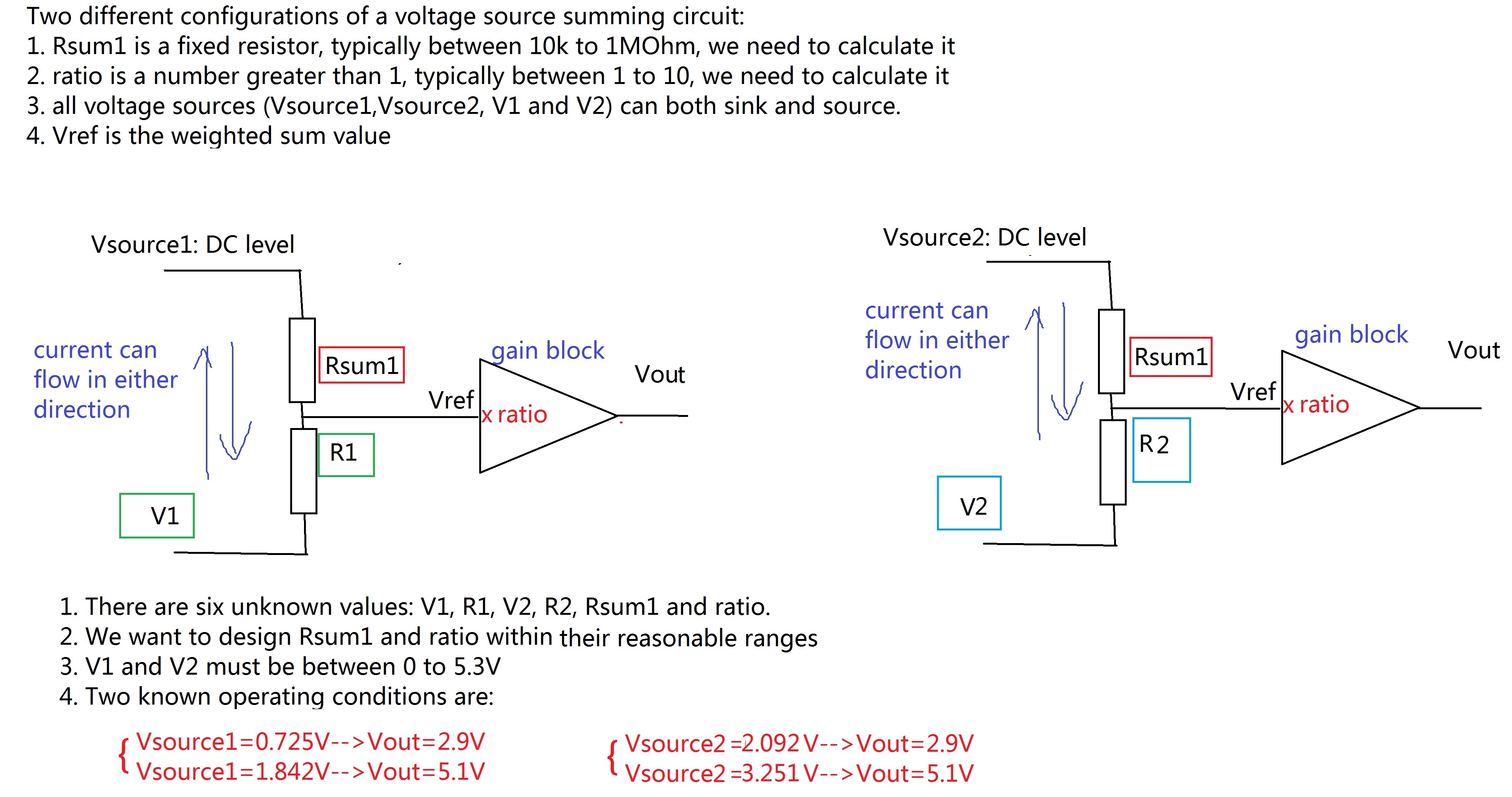
My target V1,V2 are within 0 to 5.3V, and target 10>"ratio">1, and all resistors should be between 10K to 1M ohm. Right now I am not able to use if condition to solve the equation array to figure out what V1,V2,R1,R2 are.
I have uploaded my worksheet in the attachment. Would anyone teach me how can I calculate these values within the reasonable range, by maintaining the other two parameters "ratio" and "Rsum1" within their reasonable range? Thank you!
Solved! Go to Solution.
- Labels:
-
Other
- Mark as New
- Bookmark
- Subscribe
- Mute
- Subscribe to RSS Feed
- Permalink
- Notify Moderator
Thank you Fred! Your solution is wonderful!
- Mark as New
- Bookmark
- Subscribe
- Mute
- Subscribe to RSS Feed
- Permalink
- Notify Moderator
Hi, yhuang-3,
This is a new analysis, more simple than the ones made by me previously. However, something is wrong. The values marked red are not congruent with the other results. Who could explain me why?
Greetings
FM

- Mark as New
- Bookmark
- Subscribe
- Mute
- Subscribe to RSS Feed
- Permalink
- Notify Moderator
Hi F.M.
That's happen because with that selection of the parameters, you "loose information". Can't reconstruct the given values.
Even your choice looks natural, for showing the linear dependence between voltages, this other procedure it's better:
Don't choose a gain for the amplifier and make the calculus for the resistors. As physical device only can work properly into some environments. This is, can work only for some range of resistors, which are in charge to polarize it. Work with an unknown Av, and a unknown k=R1/R2. Solve for them, and after to buy the amplifier, choose one resistor and calculate the other.
Best regards.
Alvaro.
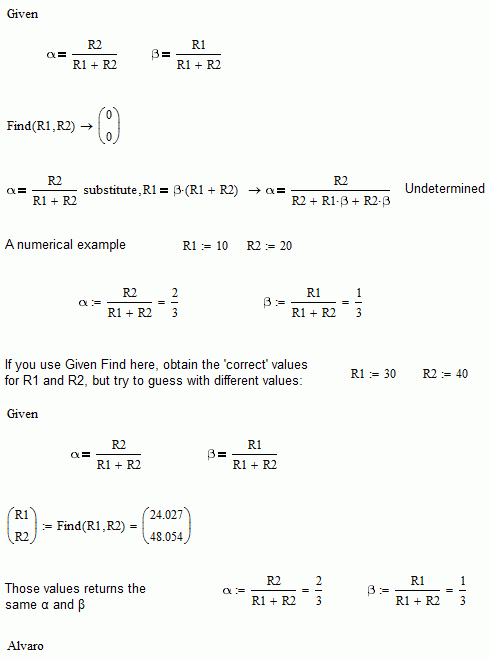
- Mark as New
- Bookmark
- Subscribe
- Mute
- Subscribe to RSS Feed
- Permalink
- Notify Moderator
...... I have my own little laboratory and I have countless opamps. But having taught electronics and theoretical systems for several decades, I do not waste my time in the lab to make the circuit.
Bye
- Mark as New
- Bookmark
- Subscribe
- Mute
- Subscribe to RSS Feed
- Permalink
- Notify Moderator
Hi F.M.
I don't telling you to make the circuit, sorry if the redaction can be interpreted for that. That's just for explain why I prefer to choice the resistor instead the gain.
Best regards.
Alvaro.
- Mark as New
- Bookmark
- Subscribe
- Mute
- Subscribe to RSS Feed
- Permalink
- Notify Moderator
Hi Yuhang-3, have you something to say about my last solution?
Look at what Grandpa has prepared for you. Do you like it so?
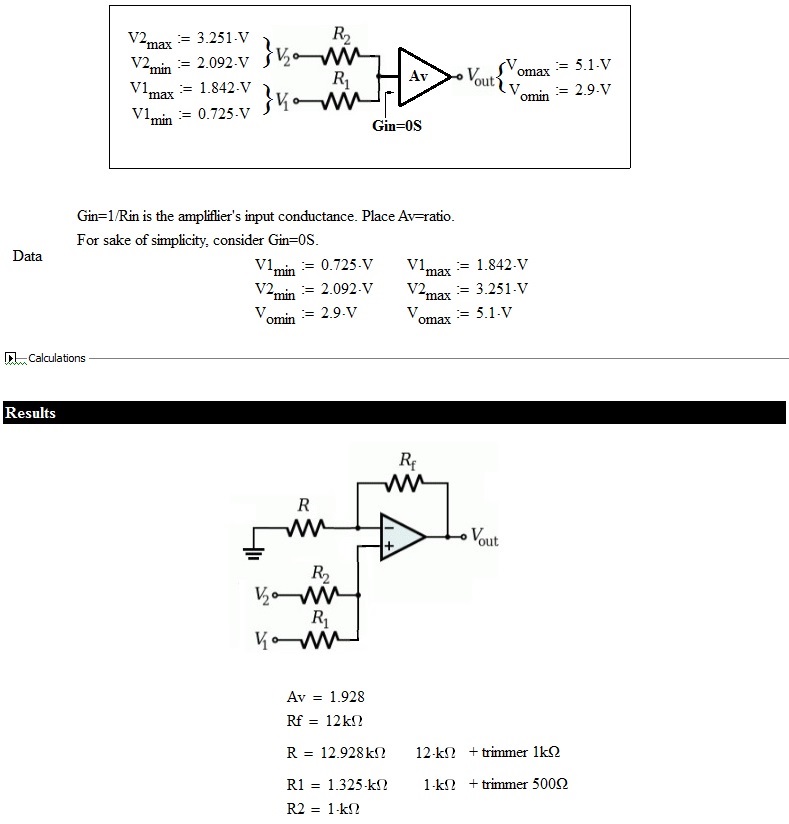
- Mark as New
- Bookmark
- Subscribe
- Mute
- Subscribe to RSS Feed
- Permalink
- Notify Moderator
Hi F.M., would you tell me how can I apply your solution to my question? In my case, the fixed DC source V1 and V2 are independent, and R1 and R2 are independent (for example, they can be connected/disconnected by a SPDT switch). But the ratio and the Rsum1 are kept the same all the time.
Thank you!

- Mark as New
- Bookmark
- Subscribe
- Mute
- Subscribe to RSS Feed
- Permalink
- Notify Moderator
My dear, but how many circuits are? can you tell us? please. I have done the analysis and synthesis for a single circuit.
Your circuit is like this:
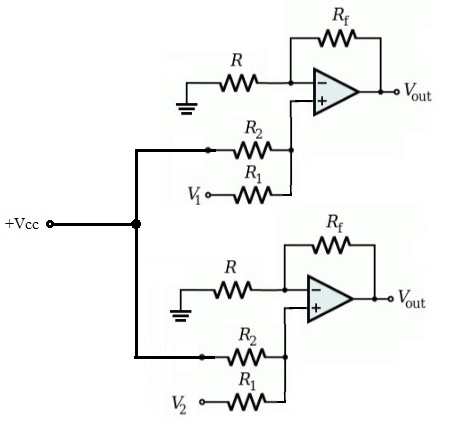
- Mark as New
- Bookmark
- Subscribe
- Mute
- Subscribe to RSS Feed
- Permalink
- Notify Moderator
Hi F.M., this one could be more accurate. Vsource can control the connection of the switch. When Vsource is between0.725 to 1.842V, the switch is connected to P1; while Vsource is between 2.092V to 3.251V, the switch is connected to P1. Thank you!
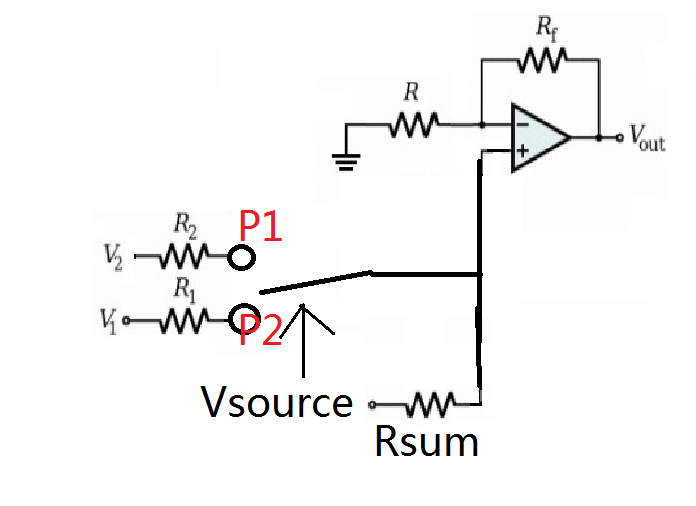
- Mark as New
- Bookmark
- Subscribe
- Mute
- Subscribe to RSS Feed
- Permalink
- Notify Moderator
Now I'm tired. We talk about the subject tomorrow, in 13 hours. Provided that in the meantime, some other user has already solved your problem.
Greetings
FM
- Mark as New
- Bookmark
- Subscribe
- Mute
- Subscribe to RSS Feed
- Permalink
- Notify Moderator
With this circuit, if you make:
R1= 13.367 kOhm
R2= 11.966 kOhm
Rsum= 54.5 kOhm
V1= 0.18331 V
V2= -0.09182 V (<<<< this one is negative!)
and set Rf= 90 kOhm and R= 10 kOhm, so that ratio= 10 you get:
When you put the switch in the P2 position and:
apply 0.725 V to Vsource then the output voltage is 2.9 V
apply 1.842 V to Vsource then the output voltage is 5.1 V
When you put the switch in the P1 position and:
apply 2.029 V to Vsource then the output voltage is 2.9 V
apply 3.251 V to Vsource, then the output voltage is 5.1 V
As far as I know, that's what you wanted (apart from V2 being negative), and that's what is calculated and simulated above, see here Solved: How to solve this simple voltage summing circuit u... - PTC Community.
Luc
- Mark as New
- Bookmark
- Subscribe
- Mute
- Subscribe to RSS Feed
- Permalink
- Notify Moderator
Hi yhuang-3
Do you think my results satisfy your problem?
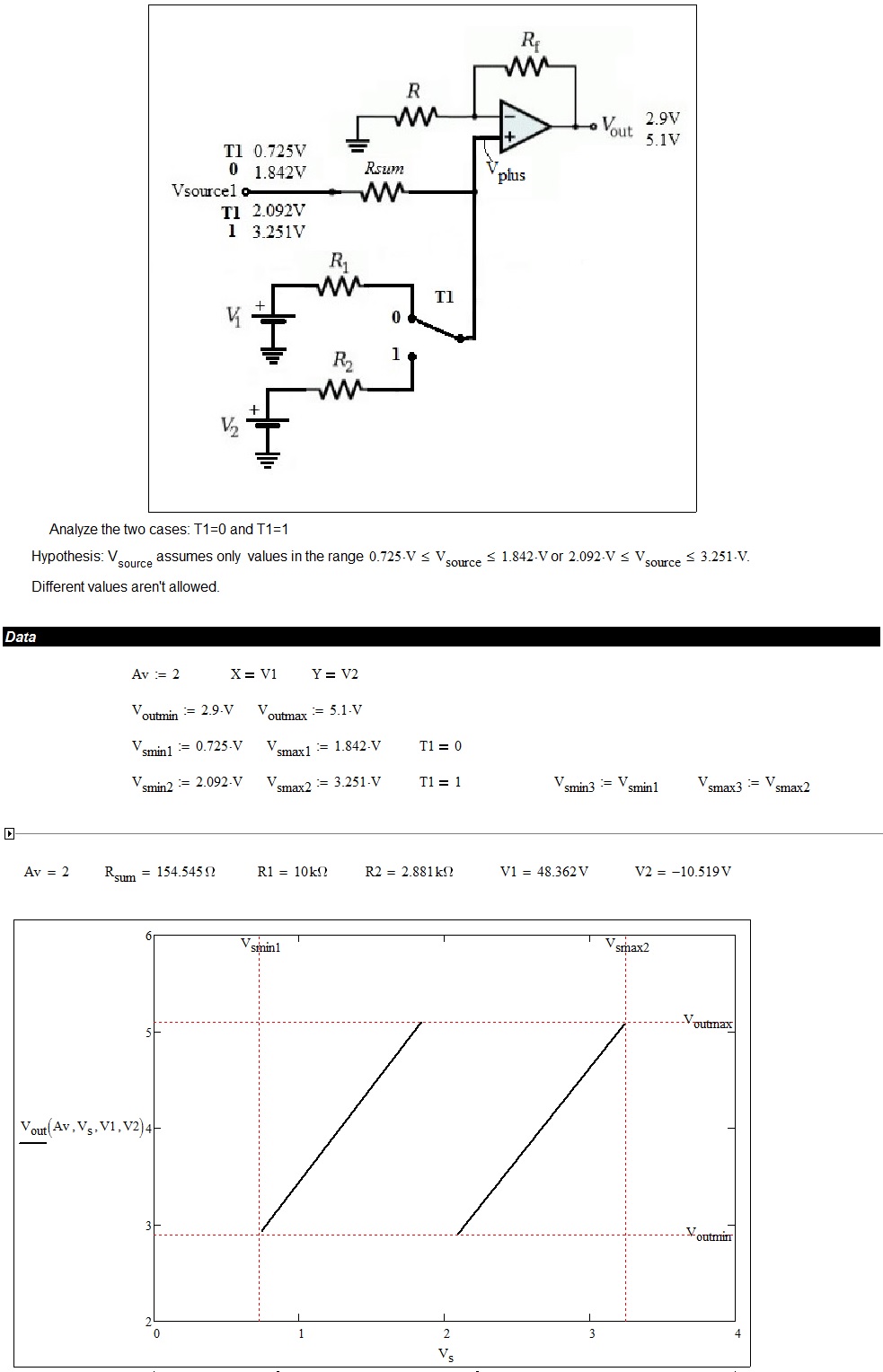
- Mark as New
- Bookmark
- Subscribe
- Mute
- Subscribe to RSS Feed
- Permalink
- Notify Moderator
Hi F.M., yes your solution is good. Originally I was looking for a solution with both V1 and V2 stays between 0 to 5.3V, but that seems not achievable. Your conclusion confirms that it is not feasible to have both V1 and V2 stay positive. Thank you!
- Mark as New
- Bookmark
- Subscribe
- Mute
- Subscribe to RSS Feed
- Permalink
- Notify Moderator
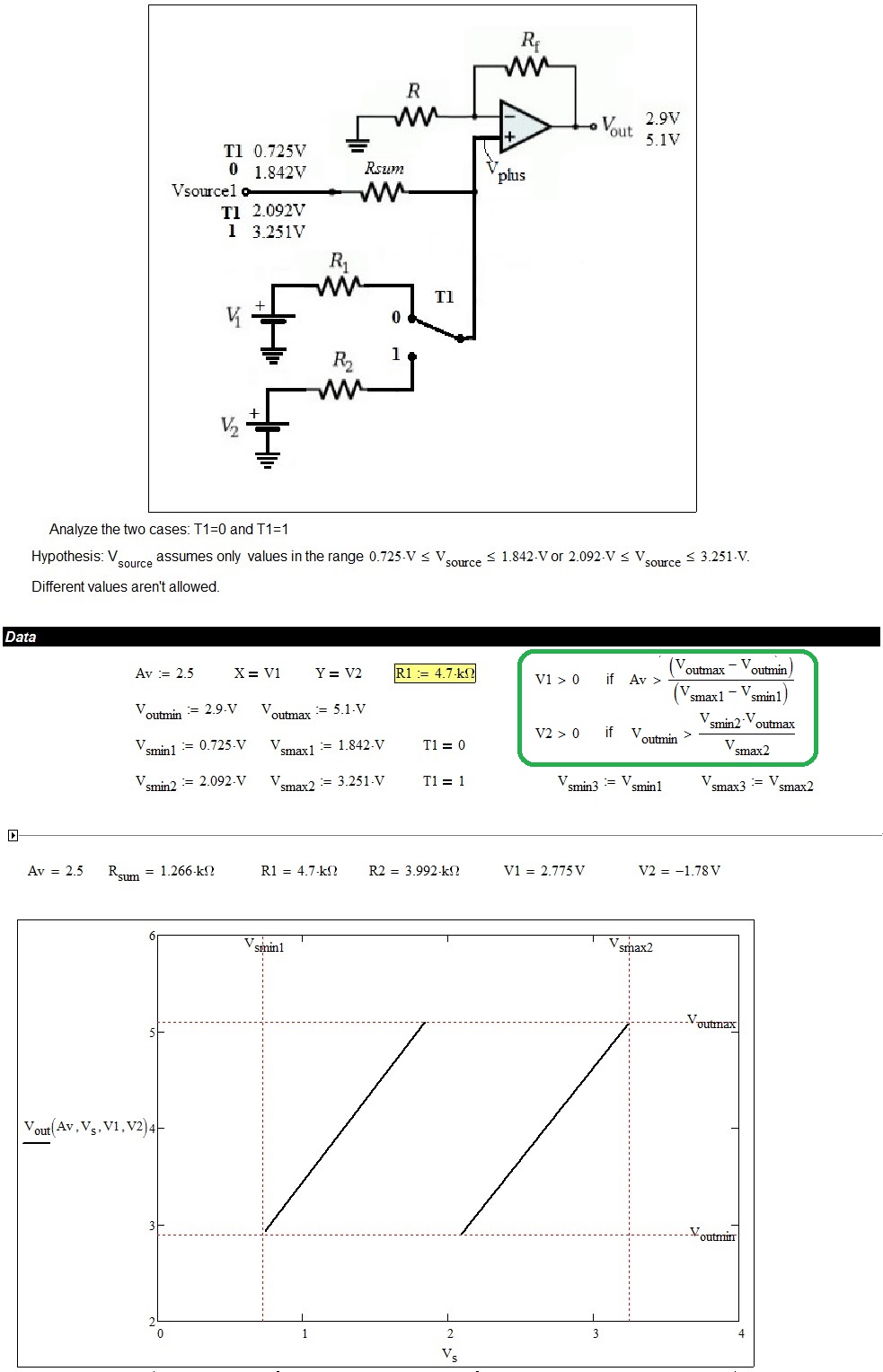
- Mark as New
- Bookmark
- Subscribe
- Mute
- Subscribe to RSS Feed
- Permalink
- Notify Moderator
I was just curious to see the output signal when the input signals V1 and V2 are two unipolar square-waves of different frequencies, and here's the result:
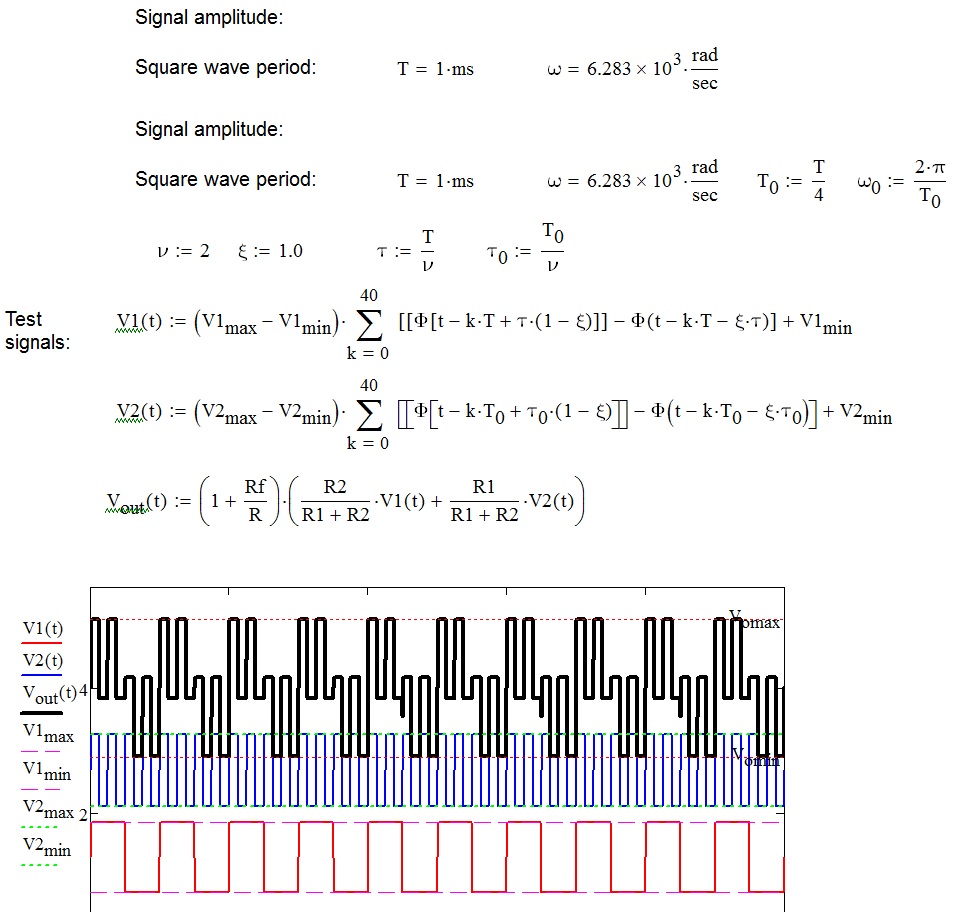
- Mark as New
- Bookmark
- Subscribe
- Mute
- Subscribe to RSS Feed
- Permalink
- Notify Moderator
Hi F.M. What about V2 vs Vout and V1 vs Vout?
Best regards.
Alvaro.
- Mark as New
- Bookmark
- Subscribe
- Mute
- Subscribe to RSS Feed
- Permalink
- Notify Moderator
Hi A.D.,
I I'll have to refine the graph. The return to zero, there should not be.
Greetings
F.M.
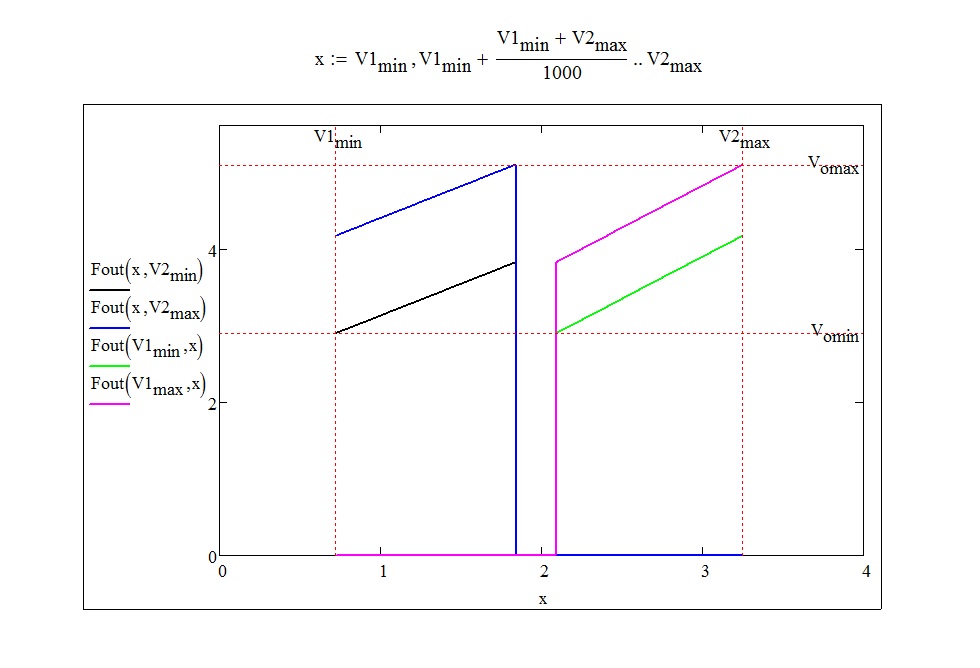
- Mark as New
- Bookmark
- Subscribe
- Mute
- Subscribe to RSS Feed
- Permalink
- Notify Moderator
A 'switch' have three terminals, as you show in your diagram. But in a typical voltage controlled switch, one of them is ocuppied by the controler, and only remain two terminals. And those two terminals can't act as selector, as in your diagram.
Best regards.
Alvaro.
- Mark as New
- Bookmark
- Subscribe
- Mute
- Subscribe to RSS Feed
- Permalink
- Notify Moderator
Hi Alvaro. This is just a block diagram, not the real circuit implementation. Thank you for pointing this out!
- « Previous
- Next »





